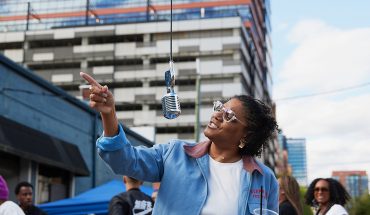King Nobuyoshi Godwin’s bright, layered paintings
by Samantha Gratton
photographs by Lissa Gotwals
Bright colors teeming with numbers fill the canvases that hang throughout the small but cozy studio with slanted ceilings. Two different songs from completely different genres play simultaneously – on a phone and through the speakers behind him. In the center sits King Nobuyoshi Godwin, silently painting as his aide and parents look on.
It is a room full of unlikely but perfect pairs: colors with numbers, music on top of music, and an artist with autism. As Godwin finishes painting a house on a recent weekday morning, he says it is having an “OK day” because “it is raining.” Next, he begins working on a blue canvas with a seahorse which is “71”. Godwin has painted hundreds of canvases, has his work in several retail spaces in Raleigh, and was awarded a merit award at last year’s Artsplosure.
As his mother explains, Godwin’s autism isn’t a disability but an ability when it comes to his art. At just two years old, Godwin was diagnosed with autism. Now, at 26, he lives independently in an apartment and works as an artist.
His life as an adult has structure and routine, because this is how he likes it best. Each day starts at 7 a.m. with a movie and breakfast. Godwin’s full-time aide, Lori Morgan, assigned by the Autism Society of North Carolina, arrives daily at 10 a.m. On Mondays through Thursdays, they go to his studio at Moondog Fine Arts to paint for three hours. The afternoons have a bit more variety, but still follow a routine. Mondays are for laundry, Tuesdays and Thursdays are for swimming. He cooks his own meals, watches a lot of movies, constantly listens to music, and loves to paint.
Growing up, he attended public school with special programming, which was available to him until he was 21. From there, he went to UNC-Greensboro for one year to attend a program called Beyond Academics, which supports students with intellectual and developmental disabilities as they learn how to live independently and explore potential career options. Godwin was told his possible job choices included sorting items at a thrift store or stacking cans in a grocery store. Godwin’s mom, Yuko Nogami Taylor, also a painter, asked Godwin, “Would you like to do that?”
No, Godwin felt it would be too easy. Wanting to find something that would challenge and excite him, they set out to figure out what he could do. After Taylor offered several options, Godwin chose painting. Together they went to a bookstore and scoured magazines as she asked him what style he wanted to paint. Godwin picked something with bright colors and repeating shapes (far different from Taylor’s own style). He started small with colors and circles. One day, Taylor told her son that he needed to put feelings in his paintings. That’s when the numbers started to appear.
While Godwin does speak, he typically only responds with two or three words. It was once Godwin started painting numbers at the age of 22 that his parents began to understand, for the first time, that Godwin’s thoughts and emotions are best felt and expressed through numbers and colors. Upon first glance at a piece by Godwin, the numbers may seem more like texture in the painting. If you look closer, you will see that every inch of the canvas is covered in painted numbers.
The numbers are not based on a linear scale rating his feelings from bad to good; they are based on a pattern and a connection, known only to Godwin, between both the colors and numbers. Purple and yellow are the happiest. Orange is positive. Numbers 11, 15, and 71 are often used and are all good. Red is not so good. And seven is bad – written as 07, it is not to be confused with 77 repeated on the painting, which is good.
“You can really see his humor in some of the paintings and the titles that he gives the paintings,” says his father, Thomas Taylor Jr. Godwin’s parents say their son’s art has helped them experience more of his personality. They understand Godwin’s perspective better now through his paintings.
Godwin has a specific creative process and a routine when it comes to his art. He readies the canvas with an initial coat of brightly colored acrylic paint. These color schemes were not taught to him; he knows them and feels them intuitively. He speeds up the drying process by using a hair dryer, eager to move on to the next stage. In another bright color, Godwin meticulously draws the animal, plant, or object to be the subject of the piece. Every line is delicate and precious, painted until it “feels good” to him. Many of the animals or objects have faces, but usually with mouths drawn in straight lines. Morgan says she thinks this is because those with autism have a harder time reading facial expressions for emotions. Then, Godwin uses bright Japanese paint pens to number everything, sometimes using different numbers throughout different sections of the canvas. He frames and names each piece of artwork before it goes up for sale.
“He paints every day with the same level of enthusiasm because he truly loves to make others happy with his art. All of his creations are a testament to the type of person that he is,” says Morgan. “King has the kindest soul and his mere presence will light up a room.” As soon as he arrives at his studio each day, Godwin starts listening to several different sources of music. Whether at home, in the car, or in his studio, he plays songs in multiples, listening to several songs from different styles and genres at the same time. Sometimes he has up to five devices playing simultaneously. Instead of sounding like overstimulated noise, it truly sounds like a new form of music.
Music is not only a part of Godwin’s creative process but also a significant part of his life and his upbringing. His father is a jazz drummer, whereas Godwin plays Taiko drums as a part of a ceremonial Japanese drum performance group. And his memory is uniquely tied to music.
Godwin remembers exactly what situation happened with a specific song, even with a library of thousands of songs to choose from. There is a reason Godwin’s work looks completely original. While Godwin may not often speak verbally, art is how he expresses himself. His autism shapes his paintings with his unique perspective and voice. At 26, both of his parents say Godwin is proud of who he is and knows his strengths. The painting is simply evidence. As his father says, “He doesn’t have to say much to make a great impact.”
Godwin’s work can be found locally at HandmeUps, Lucky Tree, Moondog Fine Arts, and Read With Me. His newest collection is on display at Artspace through April 28.






